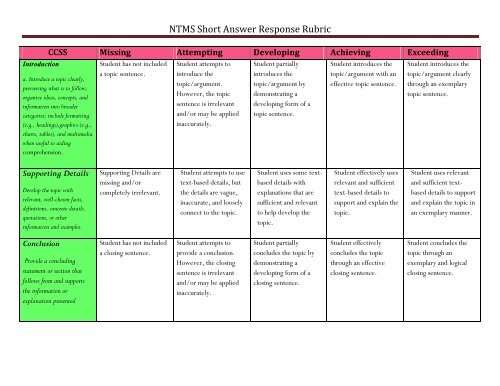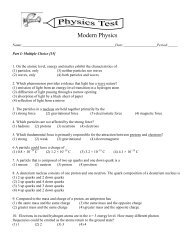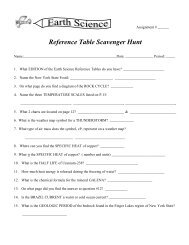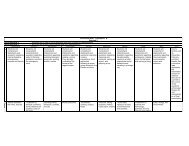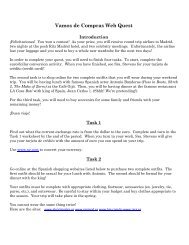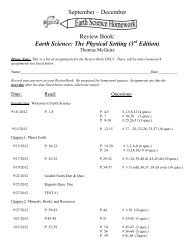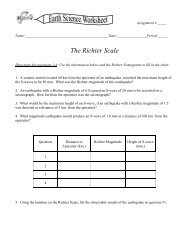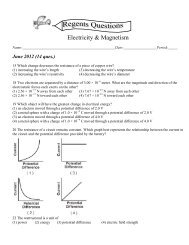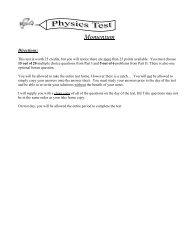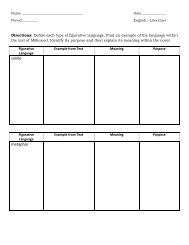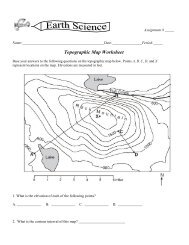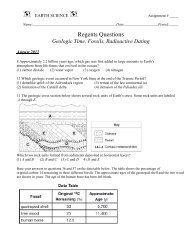NTMS Short Answer Response Rubric
NTMS Short Answer Response Rubric
NTMS Short Answer Response Rubric
Create successful ePaper yourself
Turn your PDF publications into a flip-book with our unique Google optimized e-Paper software.
Introduction<br />
<strong>NTMS</strong> <strong>Short</strong> <strong>Answer</strong> <strong>Response</strong> <strong>Rubric</strong><br />
CCSS Missing Attempting Developing Achieving Exceeding<br />
a. Introduce a topic clearly,<br />
previewing what is to follow;<br />
organize ideas, concepts, and<br />
information into broader<br />
categories; include formatting<br />
(e.g., headings),graphics (e.g.,<br />
charts, tables), and multimedia<br />
when useful to aiding<br />
comprehension.<br />
Student has not included<br />
a topic sentence.<br />
Student attempts to<br />
introduce the<br />
topic/argument.<br />
However, the topic<br />
sentence is irrelevant<br />
and/or may be applied<br />
inaccurately.<br />
Student partially<br />
introduces the<br />
topic/argument by<br />
demonstrating a<br />
developing form of a<br />
topic sentence.<br />
Student introduces the<br />
topic/argument with an<br />
effective topic sentence.<br />
Student introduces the<br />
topic/argument clearly<br />
through an exemplary<br />
topic sentence.<br />
Supporting Details<br />
Develop the topic with<br />
relevant, well-chosen facts,<br />
definitions, concrete details,<br />
quotations, or other<br />
information and examples.<br />
Supporting Details are<br />
missing and/or<br />
completely irrelevant.<br />
Student attempts to use<br />
text-based details, but<br />
the details are vague,<br />
inaccurate, and loosely<br />
connect to the topic.<br />
Student uses some textbased<br />
details with<br />
explanations that are<br />
sufficient and relevant<br />
to help develop the<br />
topic.<br />
Student effectively uses<br />
relevant and sufficient<br />
text-based details to<br />
support and explain the<br />
topic.<br />
Student uses relevant<br />
and sufficient textbased<br />
details to support<br />
and explain the topic in<br />
an exemplary manner.<br />
Conclusion<br />
Provide a concluding<br />
statement or section that<br />
follows from and supports<br />
the information or<br />
explanation presented<br />
Student has not included<br />
a closing sentence.<br />
Student attempts to<br />
provide a conclusion.<br />
However, the closing<br />
sentence is irrelevant<br />
and/or may be applied<br />
inaccurately.<br />
Student partially<br />
concludes the topic by<br />
demonstrating a<br />
developing form of a<br />
closing sentence.<br />
Student effectively<br />
concludes the topic<br />
through an effective<br />
closing sentence.<br />
Student concludes the<br />
topic through an<br />
exemplary and logical<br />
closing sentence.
<strong>NTMS</strong> <strong>Short</strong> <strong>Answer</strong> <strong>Response</strong> <strong>Rubric</strong><br />
CCSS Missing Attempting Developing Achieving Exceeding<br />
Sentence Structure<br />
-Choose among simple,<br />
compound, complex, and<br />
compound-complex sentences to<br />
signal differing relationships<br />
among idea<br />
- Use appropriate and varied<br />
transitions to create cohesion<br />
and clarify the relationships<br />
among ideas and concepts.<br />
Sentence structure lacks<br />
any variation.<br />
Missing transitions to<br />
create cohesion.<br />
Student attempts to vary<br />
sentence structure and<br />
includes few, if any,<br />
transitions to create<br />
cohesion or clarify the<br />
relationships among ideas<br />
and concepts.<br />
Student is developing a<br />
varied, but inconsistent,<br />
use of sentence structure<br />
with transitions that<br />
partially link the major<br />
sections of the text,<br />
creating cohesion,<br />
and/or clarifying the<br />
relationships among ideas<br />
and concepts.<br />
Effective use of varied<br />
sentence structure with<br />
transitions that are<br />
effective, creating<br />
cohesion, and/or<br />
clarifying the<br />
relationships among ideas<br />
and concepts.<br />
Exemplary use of varied<br />
sentence structure with<br />
transitions, creating<br />
cohesion, and/or<br />
clarifying the<br />
relationships among ideas<br />
and concepts.<br />
Vocabulary & Style<br />
- Use precise language and<br />
domain-specific vocabulary<br />
to inform about or explain<br />
the topic.<br />
-Establish and maintain a<br />
formal style.<br />
Student does not<br />
establish an appropriate<br />
style and/or tone using<br />
below grade-level<br />
vocabulary or language<br />
that is specific to the task<br />
Student attempts to<br />
establish a taskappropriate<br />
style and<br />
tone through the use of<br />
grade-level vocabulary<br />
and/or language<br />
appropriate to the task.<br />
Student partially<br />
establishes a taskappropriate<br />
style and<br />
tone through an<br />
inconsistent use of gradelevel<br />
vocabulary and/or<br />
language appropriate to<br />
the task.<br />
Student establishes a<br />
task- appropriate style<br />
and tone through an<br />
effective use of gradelevel<br />
vocabulary and/or<br />
language appropriate to<br />
the task.<br />
Student establishes and<br />
maintains an appropriate<br />
style and tone through<br />
an effective use of<br />
vocabulary above grade<br />
level and appropriate to<br />
the task<br />
Conventions 1.<br />
Demonstrate command of<br />
the conventions of standard<br />
English grammar and usage<br />
when writing or speaking.<br />
2. Demonstrate command of<br />
the conventions of standard<br />
English capitalization,<br />
punctuation, and spelling<br />
when writing.<br />
Writing has frequent<br />
errors in spelling,<br />
punctuation,<br />
capitalization, grammar<br />
and usage that<br />
significantly interfere<br />
with both the readability<br />
and comprehension of<br />
the piece.<br />
Writing has many errors<br />
in spelling, punctuation,<br />
capitalization, grammar<br />
and usage that somewhat<br />
interfere with the<br />
readability of the piece.<br />
Writing has several<br />
errors in spelling,<br />
punctuation,<br />
capitalization, grammar<br />
and usage that detract<br />
from the readability or<br />
voice of the piece.<br />
Writing has some errors<br />
in spelling, punctuation,<br />
capitalization, grammar<br />
and usage that are<br />
repetitive, but do not<br />
interfere with the<br />
readability or voice of the<br />
piece.<br />
Writing has few, if any,<br />
errors in spelling,<br />
punctuation,<br />
capitalization, grammar<br />
and usage.
<strong>NTMS</strong> <strong>Short</strong> <strong>Answer</strong> <strong>Response</strong> <strong>Rubric</strong>


